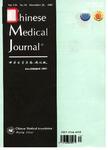Efficacy evaluation for the treatment of unstable lumbar disc herniation by traditional and modified lamina osteotomy replantation
Efficacy evaluation for the treatment of unstable lumbar disc herniation by traditional and modified lamina osteotomy replantation作者机构:Xi An Jiao Tong Univ Coll Med Shaanxi Prov Pepoples Hosp Affiliated Hosp 3Dept Orthopaed Xian 710061 Shaanxi Peoples R China Xi An Jiao Tong Univ Coll Med Shaanxi Prov Pepoples Hosp Affiliated Hosp 3Dept Neurosurg Xian 710061 Shaanxi Peoples R China Xi An Jiao Tong Univ Coll Med Dept Fac Publ Hlth Xian 710061 Shaanxi Peoples R China
出 版 物:《Chinese Medical Journal》 (中华医学杂志(英文版))
年 卷 期:2013年第126卷第15期
页 面:2840-2845页
核心收录:
学科分类:090603[农学-临床兽医学] 0831[工学-生物医学工程(可授工学、理学、医学学位)] 1004[医学-公共卫生与预防医学(可授医学、理学学位)] 1002[医学-临床医学] 08[工学] 09[农学] 0906[农学-兽医学] 10[医学]
基 金:This study was supported by grants from the National Natural Science Foundation of China the Science and Technology Research and Development of Shaanxi Province the Science and Technology Program of Shaanxi Province the Science and Technology Plan Project of Xi'an (No.HM1121
主 题:lumbar disc herniation lamina replantation spine clinical outcome
摘 要:Background The traditional lamina osteotomy replantation method is prone to nerve root injury and low back pain recurrence. Our team has proposed a modified approach that improves the osteotomy site and its fixation procedure. The aim of this study was to evaluate the clinical efficacy of traditional and modified lamina replantation methods in treating unstable lumbar disc herniation. Methods From March 2008 to August 2011, 124 patients with unstable lumbar disc herniation were enrolled and randomly divided into the following two groups according to random digital table: group A (traditional group) consisting of 61 patients who underwent traditional laminectomy replantation, and group B (modified group) consisting of 63 patients who underwent modified lamina replantation. Both surgeries were performed by the same surgeons. The two groups had no significant difference in gender, age, symptoms, time of onset and the prominent segment. Visual analogue scale (VAS), Oswertry disability index (ODI), and Japanese Orthopaedic Association (JOA) scores, operative time, blood loss, complication rate, radiographic healing rates, and low back pain recurrence rates were compared between the two groups. Results There were 121 patients followed up for more than one year, and the follow-up rate was 97.6%. Nerve injury occurred in two patients (3.3%) in the modified group and 12 patients (20.0%) in the traditional group. Dural injury occurred in one patient (1.6%) in the modified group and seven patients (11.7%) in the traditional group. Pseudarthrosis occurred in two patients in the modified group and in 18 patients in the traditional group with 1-year fusion rates of 96.7% and 70.0%, respectively. Recurrence of lower back pain after one year was noted in three patients (4.9%) in the modified group, and in 15 (25.0%) in the traditional group. Leg pain recurrence was noted in one patient (1.6%) in the modified group and in three cases (5.0%) in the traditional group. The one-year hea



